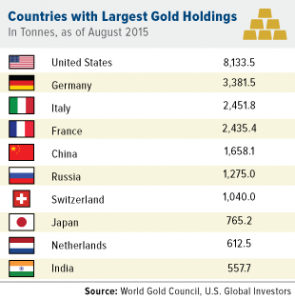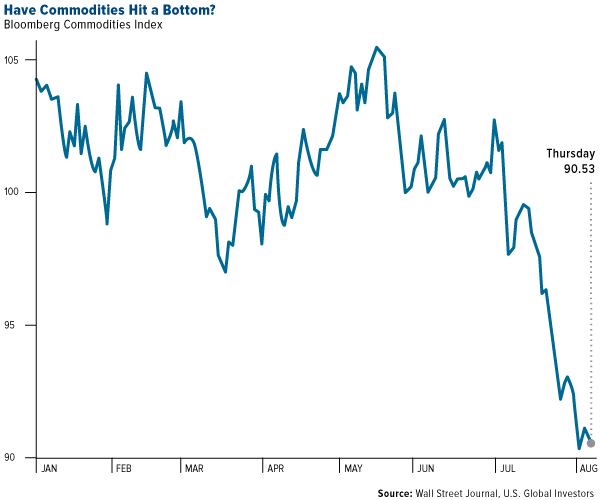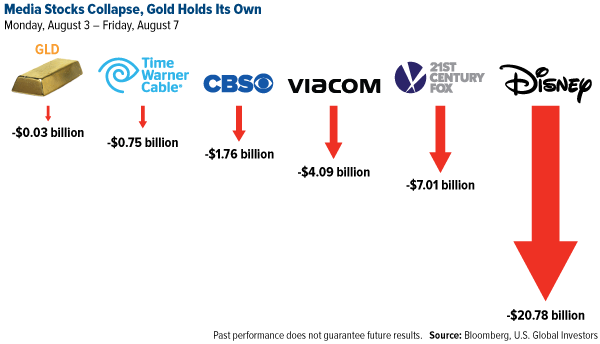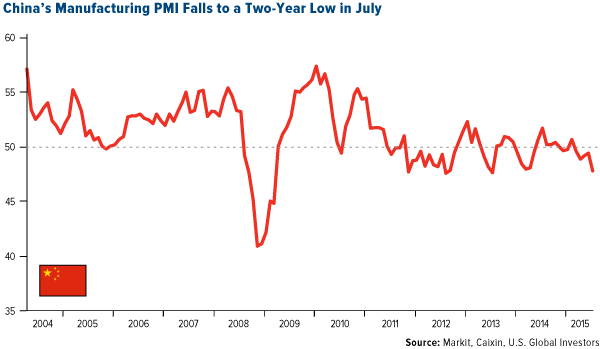There's no other way to put it: Commodities took it on the chin last month.
July was the seventh worst performing month for the S&P Goldman Sachs Commodities Index going back to January 1970. Crude oil saw its steepest monthly loss since October 2008. Both copper and aluminum touched their lowest levels in six years. And on July 19, possibly as a result of deliberate price manipulation, gold experienced a mini flash crash, sending gold prices down to five-year lows.
Regardless, several commodities are beating the exchange-traded funds that track them for the one-year period, according to The Wall Street Journal. The U.S. Global Investors Gold and Precious Metals Fund (MUTF: USERX) is over 1,900 basis points ahead of the Market Vectors Gold Miners ETF (NYSE Arca: GDX) year to date.
But that hasn't stopped many gold bears from using this as an opportunity to disparage the yellow metal. A recent Bloomberg article points out that the gold rout has cost China and Russia $5.4 billion, an amount that would sound colossal were it not for the fact that U.S. media companies such as Walt Disney Co. (NYSE: DIS) and Viacom Inc. (Nasdaq: VIAB) collectively lost over $60 billion for shareholders in as little as two days last week.
Below are the weekly losses for just a handful of those companies. Compared to many other asset classes, gold has held up well, even after factoring in its price decline.
And isn't it funny that the U.S. Federal Reserve doesn't keep other countries' currencies, but it continues to hold gold - and in larger amounts than any other central bank? China and Russia have two of the biggest gold reserves in the world - and have added to them recently - but they don't come close to the Fed's holdings, even when combined. What's more, the U.S. Treasury's Office of the Comptroller of the Currency just classified gold as money by placing gold futures in the foreign exchange derivatives classification.
 Indeed, central banks all over the world continue to add to their gold reserves. If the metal were as valueless as a pet rock, as one Wall Street Journal op-ed recently claimed, why would they bother to do this? A few weeks ago, China disclosed the amount of gold its central bank holds for the first time in six years. Global markets reacted negatively that the country increased its reserves "only" 57%. But the World Gold Council (WGC) saw this as positive news:
Indeed, central banks all over the world continue to add to their gold reserves. If the metal were as valueless as a pet rock, as one Wall Street Journal op-ed recently claimed, why would they bother to do this? A few weeks ago, China disclosed the amount of gold its central bank holds for the first time in six years. Global markets reacted negatively that the country increased its reserves "only" 57%. But the World Gold Council (WGC) saw this as positive news:
As I've said before, China is the 800-pound commodities gorilla. This has largely been the case since 2000.
Half a Trillion Dollars a Year in Commodities
Between 2002 and 2012, China was growing fast at an average annual pace of around 10%. The country was responsible for nearly all of the net increase in global metals consumption between 2000 and 2014, according to the World Bank. Over the same time period, its share of metals consumption tripled, eventually reaching an astounding 47%.
The year 2014 was a standout for Chinese commodity imports. Compelled by low prices, the country, which accounted for 12% of worldwide imports, brought in record volumes of crude oil, iron ore, copper, and other raw materials.
Because China is a trading partner with practically every other country, and because it imports over $500 billion a year in commodities, its importance in global trade cannot be stressed enough. BBVA Research writes that "any reduction in its level of [purchasing] activity places significant downward pressure on the prices of [commodities], such as oil or copper."
And yet we're seeing that reduction now. For the past five months, China's purchasing managers' index (PMI) has remained below the neutral 50 mark, indicating that its manufacturing sector has been in contraction mode for the better part of this year so far.
It's important to keep in mind that China is still the number one importer of many key materials, including coal, iron ore, and crude oil. The country's import growth of these commodities continues to rise, but at a slower pace than in years past.
This isn't necessarily the case with gold, however.
Demand Still Higher Than the Five-Year Average
According to the WGC, the decline in Chinese gold demand has been overstated.
The WGC also points out that gold has a low correlation with and different demand drivers than commodities. Whereas commodities, as expressed by the Bloomberg Commodities Index, have returned to 2001 levels, gold is still up significantly for the period shown in the chart below.
As many of you know, I call gold's drivers the Fear Trade and the Love Trade.
The Fear Trade, dominant in the psyche of North America, involves money supply growth and real interest rates. Whenever the United States has negative real interest rates, gold starts to rise in dollar terms, and whenever we have positive real rates of return, it starts to decline. If you go back to 2011, we had negative real interest rates of 3% on a 10-year government bond, and the average gold price that year was around $1,500 per ounce. But now that rates are positive 2%, the metal's been depressed.
The Love Trade includes the purchase of the precious metal due to cultural affinity and rising GDP per capita in Asia and the Middle East. This includes gift giving of bullion and gold jewelry in anticipation of upcoming festivals such as Diwali, Christmas, and the Chinese New Year. Historically, the Love Trade begins to pick up around this time of the year.
Gold is a long-term investment with long-standing tradition. This remains true even now that gold prices have declined. As always, I recommend a 10% weighting: 5% in gold stocks and 5% in bullion or jewelry, then rebalance every year.
[Editor's Note: Frank Holmes is chief executive officer and chief investment officer of U.S. Global Investors Inc., which manages a diversified family of mutual funds and hedge funds specializing in natural resources, emerging markets, and infrastructure. He has been profiled by Fortune, Barron's, Financial Times, and other publications. If you want commentary and analysis from Holmes and the rest of the U.S. Global Investors team delivered to your inbox every Friday, sign up to receive the weekly Investor Alert at www.usfunds.com.]
Follow us on Twitter @moneymorning.
China Has a Long-Time Affinity for Gold... For the past several years, it's consistently been one of the top two gold consumers worldwide. It's also the world's largest gold producer. Now China wants to exert more influence over the gold market - and gold prices. Here's how the Asian nation aims to do just that...
Related Articles:
- U.S. Global Investors: Frank Talk Blog: Gold on Sale, Says the Rational Investor
- BVVA Research: Global Economic Outlook, Third Quarter 2015
- Bloomberg: Gold Crash Costs Russia and China $5.4 Billion in Just Three Weeks
- The Wall Street Journal: Let's Be Honest About Gold: It's a Pet Rock







